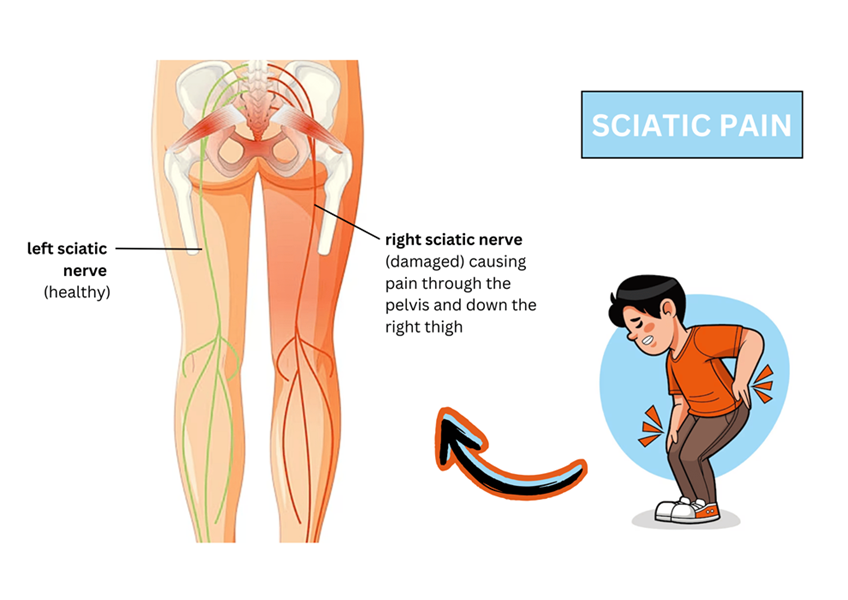
You’re walking across the room, and suddenly — there it is. That deep, shooting pain down your lower back or leg that makes you stop in your tracks. Maybe it’s a dull ache today, but tomorrow? It might feel like someone plugged a live wire into your hip.
If you’ve ever experienced this kind of pain, there’s a good chance you’re dealing with sciatica symptoms.
Sciatica isn’t just “back pain.” It’s a nerve issue — and when the largest nerve in your body (the sciatic nerve) gets irritated, it makes sure you know it.
But here’s the real question: How do you know if it’s just soreness… or something more serious? And if it is sciatica, how do you find real, lasting relief without making things worse?
Let’s break it down.
✅ Key Takeaways
-
Sciatica often starts in the lower back and radiates down one leg.
-
Symptoms can range from tingling to stabbing pain or weakness.
-
Ignoring worsening signs can lead to nerve damage or loss of mobility.
-
Early self-care like stretching, posture correction, and movement can help.
-
Persistent or severe symptoms may need medical help, especially if it affects bladder/bowel control.
🧠 What Is Sciatica, Really?
Sciatica isn’t a condition itself — it’s a symptom of something pressing on or irritating your sciatic nerve.
This long nerve starts in your lower spine and runs through your hips, buttocks, and all the way down each leg. So when it gets compressed? You feel it.
Common causes of sciatica include:
-
A herniated (slipped) disc
-
Spinal stenosis (narrowing of the spinal canal)
-
Degenerative disc disease
-
Piriformis syndrome
-
Injury or trauma
-
Prolonged sitting with poor posture
It’s more common than you think — about 40% of people will experience sciatica at some point in their lives, according to Harvard Health【source】.
🔥 Classic Sciatica Symptoms (That People Often Dismiss)
Sciatica usually affects one side of the body. It doesn’t just stay in your back — it radiates.
⚠️ Symptoms to watch for:
1. Pain that shoots down one leg
This is the classic sign. It often starts in your lower back or buttock and travels down your thigh, calf, or foot. It can feel sharp, electric, or stabbing.
2. Numbness or tingling
That “pins and needles” feeling in your leg or foot might not just be from sitting funny. Sciatica can cause sensory disruption along the nerve path.
3. Muscle weakness
You may notice it’s harder to lift your foot (foot drop), stand up from a chair, or climb stairs. That’s a red flag your nerve isn’t functioning properly.
4. Burning or searing sensation
Not everyone gets stabbing pain — some people describe it as burning heat under the skin, especially along the hamstrings or calf.
5. Pain that worsens when you sit
Oddly, sciatica pain often gets worse when you’re sitting — especially if you slump or hunch forward.
6. Sudden jolts with movement
Coughing, sneezing, or even laughing may cause sudden bursts of pain down your leg. That’s a clue there’s nerve compression at play.
🚨 When Sciatica Symptoms Are a Medical Emergency
Most sciatica cases resolve on their own. But sometimes, it’s more than just an irritated nerve — and waiting it out can lead to serious consequences.
Here’s when you need to stop Googling and call a doctor immediately:
-
You lose control of your bladder or bowels.
-
You experience numbness in your groin or inner thighs (“saddle anesthesia”).
-
You can’t move your foot or leg.
-
The pain is severe and constant, even when resting.
These symptoms could point to something serious like cauda equina syndrome, which needs emergency treatment.
👉 If you’re unsure, it’s always safer to get checked out.
🧍♀️ Why Posture and Lifestyle Play a Huge Role
You don’t have to be a gym rat or a construction worker to get sciatica.
In fact, many people develop it just by:
-
Sitting too long (especially at work)
-
Driving for hours without breaks
-
Sleeping on an unsupportive mattress
-
Carrying a heavy bag on one side
-
Skipping movement and stretches altogether
Think about it: Your spine isn’t meant to be still. The more you sit — especially with poor posture — the more likely those spinal discs are to shift, shrink, or bulge.
Over time, this compresses the sciatic nerve.
🧘♂️ How to Ease Sciatica Pain Naturally (At Home)
Good news: Most sciatica symptoms improve within a few weeks — especially if you catch it early and don’t push through the pain.
Here’s what actually helps:
1. Keep moving (but gently)
Lying in bed all day? It often makes things worse.
Try:
-
Short walks around the block
-
Gentle yoga (especially stretches for the hamstrings and hips)
-
Low-impact exercise like swimming or cycling
Movement keeps your spine flexible and reduces inflammation.
2. Try heat and ice therapy
-
Ice packs: helpful in the first 48 hours to reduce inflammation.
-
Heat packs: great for loosening tight muscles around the nerve after a few days.
Alternate both for 15–20 minutes, 2–3 times a day.
3. Stretch the piriformis and hamstrings
These muscles often press on the sciatic nerve when tight.
Some helpful stretches:
-
Lying figure-4 stretch
-
Seated hamstring stretch
-
Knee-to-chest stretch
Be gentle. You’re aiming for release, not a deep burn.
4. Adjust your posture
Ergonomics matter. If you sit at a desk:
-
Keep feet flat on the floor
-
Use a lumbar support pillow
-
Don’t cross your legs
-
Take standing breaks every 30–60 minutes
5. Use over-the-counter pain relief (if needed)
Nonsteroidal anti-inflammatory drugs (NSAIDs) like ibuprofen can help reduce pain and swelling short term. But avoid using them as a crutch.
“Painkillers are not a solution. They’re a short-term aid while you treat the root cause,” says Dr. Raj Rao, orthopedic spine surgeon at the University of Wisconsin.
🧑⚕️ What to Expect If You See a Doctor
If your symptoms aren’t improving after a couple of weeks, it’s worth seeing a healthcare provider. They may suggest:
-
Physical therapy
-
Prescription medication (e.g. muscle relaxants)
-
Imaging tests like MRI or CT scans
-
Corticosteroid injections
-
In rare cases, surgery (like a microdiscectomy)
According to the Mayo Clinic, surgery is usually reserved for cases where pain is severe or causing loss of function【source】.
🌀 Emotional Toll of Sciatica: It’s Not “Just Pain”
Let’s not ignore the mental load.
Living with chronic pain — especially when it affects your ability to sit, sleep, or enjoy life — can take a toll on your mood, your energy, and even your relationships.
Anxiety about “what if this never goes away?” is real.
You’re not weak. You’re human.
What helps:
-
Talking to someone (therapist, support group)
-
Mindfulness or breathing practices
-
Gentle movement to reclaim control over your body
You’re allowed to ask for help — both physical and emotional.
🌿 Can You Prevent Sciatica From Coming Back?
It depends on the cause — but in many cases, yes.
Here’s how to lower your risk of flare-ups:
-
Strengthen your core (strong abs support the spine)
-
Practice regular stretching (especially lower body)
-
Maintain a healthy weight
-
Avoid sitting too long
-
Use proper lifting techniques
-
Stay physically active (even just 20–30 mins/day)
It’s not about being perfect. It’s about protecting your spine like it protects you.
Sciatica symptoms aren’t just annoying — they can steal your mobility, your sleep, your focus, and your peace of mind.
But here’s the truth: You don’t have to live in fear or push through the pain. The earlier you recognize the signs and listen to your body, the more likely you are to heal fully — without invasive treatments.
Start small. Take care of your spine. And don’t ignore the signs your body is whispering (or shouting).
You deserve relief.
Start by standing up and stretching — your sciatic nerve will thank you.
🙋 FAQ: Sciatica Symptoms
1. Can sciatica go away on its own?
Yes — many cases resolve within 4–6 weeks with gentle movement and self-care. But if pain lasts longer or gets worse, see a doctor.
2. Is sciatica always caused by a herniated disc?
No. It can also be caused by spinal stenosis, piriformis syndrome, pregnancy, or even prolonged sitting with poor posture.
3. Should I rest or keep moving?
Light movement is better. Gentle walking, stretching, and low-impact exercise often help more than lying down all day.
4. Can sciatica affect both legs?
Typically it affects one leg, but in rare cases — especially with spinal narrowing — it may impact both.
5. Is numbness in the foot a bad sign?
Yes — especially if it doesn’t go away. Persistent numbness or weakness should be checked by a healthcare provider.
6. Can a chiropractor fix sciatica?
Some people find relief with chiropractic care, especially if the issue involves spinal misalignment. But it’s not a cure-all — and not for everyone.
7. When should I worry about sciatica pain?
If you lose bladder or bowel control, or can’t move your leg, seek emergency care. Also, if symptoms persist beyond 6–8 weeks.
8. What’s the difference between sciatica and back pain?
Back pain is usually localized. Sciatica travels — from your lower back through your hip and leg. It often includes numbness or tingling.
9. Will surgery cure my sciatica?
In some cases, yes. Especially if there’s a herniated disc compressing the nerve. But most people recover without surgery.
10. Can stress make sciatica worse?
Yes. Stress tightens muscles and increases inflammation, which can aggravate nerve pain. Mindfulness and relaxation help.

